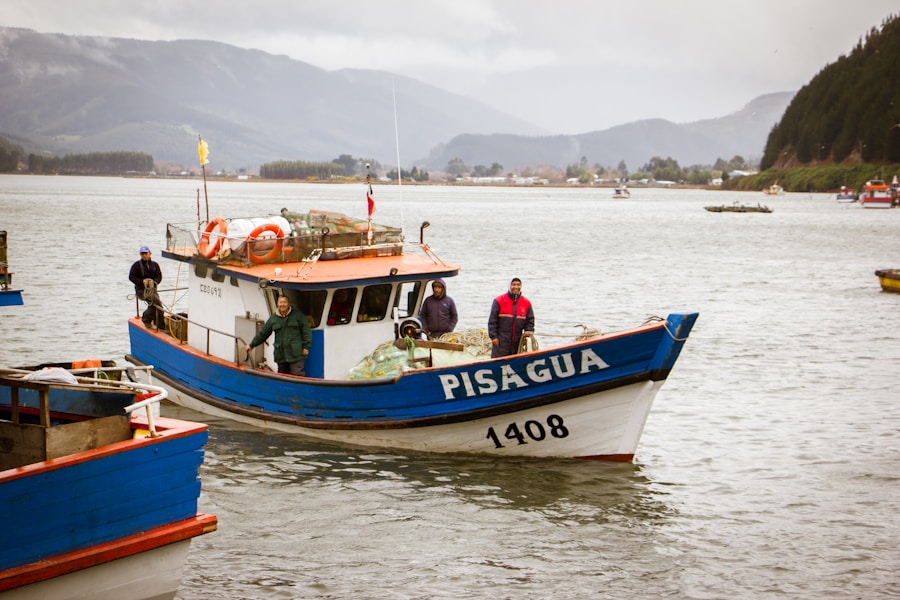Download links
How to install The Thrill of Ocean Fishing: A Deep-Sea Adventure APK?
1. Tap the downloaded The Thrill of Ocean Fishing: A Deep-Sea Adventure APK file.
2. Touch install.
3. Follow the steps on the screen.
Description
Deep-sea fishing is an exhilarating adventure that draws anglers from all walks of life. The thrill of venturing far from the shore, where the ocean depths hold the promise of massive fish, is a unique experience that combines the beauty of nature with the challenge of sport. As the boat cuts through the waves, anticipation builds among the crew, each person eager to reel in a trophy catch.
The vastness of the ocean, with its shimmering blue waters and the occasional glimpse of marine life, creates an atmosphere charged with excitement. The unpredictability of what lies beneath the surface adds an element of suspense that keeps fishermen on their toes. The act of deep-sea fishing is not merely about catching fish; it is about immersing oneself in the natural world.
The salty breeze, the sound of waves crashing against the hull, and the camaraderie shared among fellow anglers create a memorable experience. Whether it’s the adrenaline rush of battling a large marlin or the serene moments spent waiting for a bite, deep-sea fishing offers a unique blend of thrill and tranquility. Each trip can yield different results, making every outing an adventure filled with potential.
The stories shared around a campfire or at a local pub about the one that got away or the one that was caught become part of the rich tapestry of fishing lore.
Key Takeaways
- Deep-sea fishing offers an exciting and adventurous experience for fishing enthusiasts.
- The best locations for ocean fishing include popular spots like the Gulf of Mexico, the Bahamas, and the Great Barrier Reef.
- Essential gear and equipment for deep-sea fishing include a sturdy fishing rod, heavy-duty fishing line, and a variety of lures and bait.
- Tips for catching big game fish include using live bait, trolling at different depths, and being patient and persistent.
- Safety precautions for deep-sea fishing involve wearing a life jacket, checking weather conditions, and being aware of potential hazards like sharp hooks and slippery decks.
- Sustainable practices for ocean fishing include practicing catch and release, using biodegradable fishing gear, and following local fishing regulations to protect marine ecosystems.
The Best Locations for Ocean Fishing
When it comes to deep-sea fishing, location is paramount. Certain areas are renowned for their abundant marine life and provide some of the best opportunities for anglers seeking big game fish. One such location is the Florida Keys, where warm waters teem with species like sailfish, tuna, and mahi-mahi.
The Gulf Stream, which flows just offshore, brings nutrient-rich waters that attract a variety of fish, making it a prime destination for both novice and experienced fishermen. The vibrant coral reefs and underwater structures also provide excellent habitats for fish, enhancing the chances of a successful catch.
Known as the “Marlin Capital of the World,” this region offers unparalleled opportunities for catching striped marlin, blue marlin, and dorado. The convergence of warm and cold currents creates an ideal environment for diverse marine life. Anglers flock to Cabo not only for its fishing but also for its stunning landscapes and vibrant nightlife.
The combination of world-class fishing and beautiful surroundings makes it a must-visit destination for anyone serious about deep-sea fishing.
Essential Gear and Equipment for Deep-Sea Fishing

Equipping oneself with the right gear is crucial for a successful deep-sea fishing expedition. A sturdy rod and reel are fundamental components; they must be capable of handling heavy lines and large fish. Typically, anglers opt for heavy-duty rods that can withstand the strain of battling big game fish like tuna or marlin.
Reels should be equipped with high gear ratios to facilitate quick retrievals, especially when dealing with fast-swimming species. Additionally, braided lines are often preferred due to their strength and sensitivity, allowing anglers to feel even the slightest nibble. Beyond rods and reels, tackle selection plays a significant role in deep-sea fishing success.
Lures and bait must be chosen carefully based on the target species. For instance, live bait such as mackerel or squid can be incredibly effective for attracting larger fish. On the other hand, artificial lures like jigs or trolling lures can also yield impressive results when used correctly.
It’s essential to have a variety of tackle on hand to adapt to changing conditions and fish behavior. Furthermore, accessories such as tackle boxes, pliers, and fish finders enhance the overall fishing experience by ensuring that anglers are well-prepared for any situation.
Tips for Catching Big Game Fish
| Tip | Description |
|---|---|
| Use the right bait | Research the type of fish you want to catch and use the appropriate bait to attract them. |
| Check the weather | Pay attention to the weather forecast as it can affect fish behavior and feeding patterns. |
| Use the right equipment | Ensure you have the appropriate fishing rod, reel, and line for the type of big game fish you are targeting. |
| Locate the fish | Use fish finders or research the best spots to find big game fish in your area. |
| Be patient | Catching big game fish requires patience, so be prepared to wait for the right opportunity. |
Catching big game fish requires not only skill but also strategy and patience. One effective technique is to understand the feeding patterns of target species. For example, many large fish are more active during dawn and dusk when they venture closer to the surface to feed.
Planning fishing trips around these times can significantly increase the chances of success. Additionally, understanding water temperature and currents can help anglers locate schools of fish more effectively. Fish tend to congregate in areas where water temperatures are optimal for feeding, so monitoring these conditions is vital.
Another important tip is to master various fishing techniques such as trolling, bottom fishing, or live baiting.
This method can cover large areas quickly and is particularly effective for species like tuna and marlin.
Bottom fishing, on the other hand, targets species that dwell near the ocean floor, such as snapper or grouper. Using heavy weights to keep bait near the bottom can yield impressive results in these cases. Adapting techniques based on conditions and target species can make all the difference in achieving a successful catch.
Safety Precautions for Deep-Sea Fishing
Safety should always be a top priority when embarking on a deep-sea fishing adventure. The open ocean can be unpredictable, and being prepared is essential for ensuring a safe experience. One fundamental precaution is to wear life jackets at all times while on board.
Even experienced fishermen can find themselves in precarious situations due to sudden weather changes or equipment failures. Life jackets provide an added layer of security that can be lifesaving in emergencies. Additionally, it’s crucial to stay informed about weather conditions before heading out to sea.
Checking forecasts and being aware of potential storms or rough seas can help avoid dangerous situations. Having a reliable communication device on board is also essential; this could be a VHF radio or a satellite phone that allows fishermen to call for help if needed. Furthermore, creating a safety plan that includes emergency procedures and ensuring that all crew members are familiar with it can enhance overall safety during deep-sea excursions.
Sustainable Practices for Ocean Fishing

Adopting Sustainable Practices
To address this issue, anglers are encouraged to adopt sustainable fishing practices such as catch-and-release techniques. By releasing smaller or non-target species back into the water, fishermen can help maintain healthy populations while still enjoying their sport. Moreover, selecting fishing gear that minimizes environmental impact is crucial. For instance, using circle hooks instead of traditional J-hooks can reduce injury to fish that are released back into the ocean.
The Benefits of Circle Hooks
Circle hooks tend to hook fish in the corner of the mouth rather than deeper in the throat or stomach, increasing their chances of survival after being released. Additionally, being mindful of bycatch—unintended species caught during fishing—can further promote sustainability. Anglers should educate themselves about local regulations regarding size limits and protected species to ensure they are fishing responsibly.
Enjoying Sustainable Ocean Fishing
In conclusion, deep-sea fishing is an exciting pursuit that offers both challenges and rewards for those who venture into its depths. By understanding the best locations, equipping themselves with essential gear, employing effective techniques, prioritizing safety, and practicing sustainability, anglers can enjoy this thrilling sport while contributing positively to marine conservation efforts.
If you’re interested in ocean fishing, you may also enjoy reading about the popular mobile game Mario Kart Tour. Check out this article to learn more about the game’s features and gameplay.
FAQs
What is ocean fishing?
Ocean fishing, also known as deep sea fishing, is the practice of catching fish and other marine species in the open ocean. It typically involves fishing in waters that are deeper than 100 feet.
What types of fish can be caught through ocean fishing?
A wide variety of fish can be caught through ocean fishing, including tuna, marlin, swordfish, mahi-mahi, snapper, grouper, and many others. The specific types of fish that can be caught depend on the location and the time of year.
What are the methods used in ocean fishing?
Ocean fishing can be done using a variety of methods, including trolling, bottom fishing, jigging, and drift fishing. Trolling involves dragging lures or baited lines behind a moving boat, while bottom fishing involves dropping baited hooks to the ocean floor. Jigging involves using a weighted lure that is jerked up and down in the water, and drift fishing involves allowing the boat to drift with the current while fishing.
What equipment is needed for ocean fishing?
The equipment needed for ocean fishing includes fishing rods, reels, lines, hooks, lures, bait, and a boat. Depending on the specific type of ocean fishing, additional equipment such as downriggers, planers, and gaffs may also be used.
Where are popular ocean fishing destinations?
Popular ocean fishing destinations include the Gulf of Mexico, the Caribbean Sea, the Pacific Ocean, and the Atlantic Ocean. Specific locations within these regions, such as the Florida Keys, the Bahamas, Hawaii, and Costa Rica, are known for their excellent ocean fishing opportunities.





